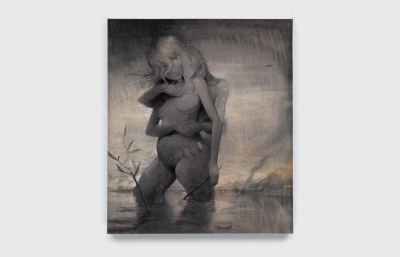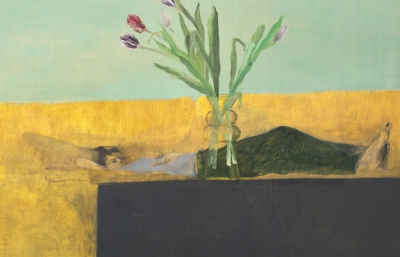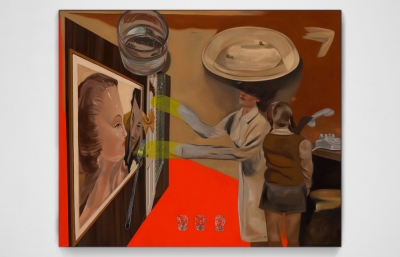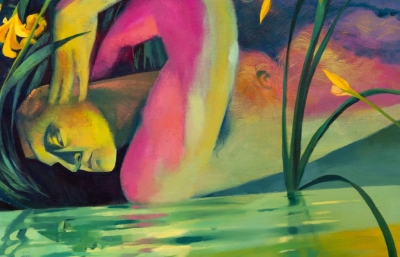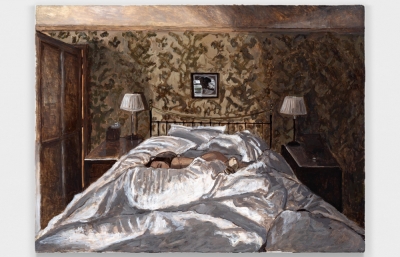José Parlá
The Very Fine Art of Sampling
Interview by Carlo McCormick // Portrait by Rey Parlá

On a bad day, in a bad place, there is often a ray of light glinting through, a lifeline in the gloaming, an illumination that makes the murk gleam like a jewel, an unexpected recognition in a nod, that rescues the solitude. José Parlá is that bit of grace we hope for, maestro conductor of the transitory moments that remain transformative. His art is aspirational and integral, rising from the bedrock, a rainbow rising from the streets, also, it seems, casting a slight smear, a shadow, on the pretty face of privilege in a trace reminder of all ignored and ignominious. I’ve loved his work since first seeing it, not so far from its gnarly roots, which since, have blossomed and become part and parcel of that great bouquet of fine art. It makes more sense, yet, a vulgar rhythm of such eloquence duets with the white man’s finest symphonies.
When the shit hits the fan, or perhaps more aptly the global pandemic hits home, it’s important to reconnect with your brothers, as it was to correspond remotely with Parlá for this interview. However, the intimacy of history is itself an estrangement of the moment, so in simple, throwaway questions we ask about health, happiness and family, suddenly fraught with imperative, as all those practical questions about art and culture hardly seem relevant. Forgive me if I forgot to ask the obvious, but am I even sure how I know José anymore? Probably should have asked him because he has a scary sort of memory. I think the first time we met, he was in an art show with a couple of pals—Dzine, Lee Quinones and Rostarr—at some bar down in Miami during a dance music convention that would far precede the advent of the cultural beast called Art Basel Miami. He’d probably correct me on this, and the when and where hardly matters anymore, but my recollection is of them painting live or showing paintings while a bunch of super hip Japanese kids were DJing. The cross-cultural hybridity and intergenerational intelligence of the event imprints me still, and somehow, continues to describe Parlá’s process and vision.

I gathered that Parlá was from Miami, with some detours as the Diaspora dictates, and probably pronounced his hometown in some Cuban fashion that would entail an entirely different spelling. By then, or shortly thereafter, Parlá relocated to New York City, like so many generations of artists, and though he has come in many ways to represent a cultural renaissance in Brooklyn, it was the Bronx that hosted his first home and studio on our now plague-ridden shores. But José Parlá’s ode to this oft-marginalized borough, in what is just now his first solo museum exhibition in NYC, is nothing like a diaristic account of his residence, though just as personal. Rather it is, much akin to all his projects, a conjuring of place and time, not in representational tableau but rendered through its sensory presence, like a sound or a flavor, the wafting aroma from a long simmering history that permeates all his work.
Parlá’s show at The Bronx Museum of The Arts, titled off the classic hip hop track, “It’s Yours” by T La Rock with DJ Jazzy Jay, is all that, a tribute to the global movement of hip hop that infected him as a young graffiti writer long before he set foot in the city, and an affirmative declaration of ownership and empowerment sent out to a disenfranchised community from one most generous and giving artist. I wish I could describe to you the opening, like a block party for the world, with so many beautiful souls and a band that proved as memorable and magnificent as the paintings. No doubt there are lots of pictures of the event floating about Instagram by now, sad reminders of just how pathetic this alone-together moment of social media interconnectivity is at delivering the essence of what it truly means to be there. It was the last party I went to, Parlá’s show, the museum and the city itself shuttered days later. Perhaps it will be the last time I will ever feel comfortable in a space that crowded or freely hug friends and strangers as we all did that night, even knowing that the virus had already arrived. And since one person I talked to that night has already been lost to Covid, many of us know in our heart that it will be the last time some of us ever see one another. In this it now remains a memory, full of love and sorrow, the very kind of emotional resonance that José Parlá has been investing in his art all along.

Carlo McCormick: Though I think you lived in the Bronx when first moving to NYC, and previously from Miami with some childhood years in Puerto Rico, you’re probably most associated as part of a wave of Brooklyn artists, especially due to your big commissions for the Brooklyn Academy of Music and the Barclays Center. Can you tell us about your show at the Bronx Museum of the Arts? Was it a tribute to the South Bronx as the cradle of hip hop, and the global influence of that movement?
José Parlá: It has been said that hip hop rose like a phoenix from the ashes of the decade of fires that absorbed the South Bronx in the 1970s. My generation witnessed its influence worldwide, and I speak as someone from Miami when hip hop exploded in the early 1980s.
My paintings resemble the surfaces of layered and textured walls, but they are really about people: their marks, our stories and the environment. Public walls are the message boards of society. I chose the title, It's Yours, partly as a tribute to the South Bronx and my own roots in hip hop culture. Being a b-boy before I was painting and becoming a writer in the early 1980s, Miami made me resilient and aware of a lot of societal problems. Crime, racial inequity, injustice, the list goes on. That is what my work is about. To connect those roots from New York to my childhood in Miami, I thought of incorporating my early sketchbooks as a way to share a kind of linear thread between my early works and my works of today. That was important to me when thinking about the exhibition because I wanted to connect with the youth educational programming. The show is about all kinds of collaborations—with the museum, the curator, local cuisine, architecture, music, and the public through all the programming we were planning before the pandemic of Covid-19. Hopefully, we can get back to that when this is all over.
Can you talk about how hip hop defined culture for your generation, and perhaps how this idea of culture as a locality, a scene, is maybe not so relevant to youth in the era of globalism?
It’s Yours is the title because, to me, it signifies a call to action and a message of belonging, because claiming ownership in who you are and where you are from is essential.
There is no entrance fee at The Bronx Museum of the Arts, it is entirely free, so It’s Yours is also an invitation to come in. It's Yours, it is part of you, which also reminded me of how, as a young artist, art was all public and, in a way, free from cost but also had so much freedom. The kind of art I grew up with was anti systematic and an outlaw style. With park jams being free, painting walls for the public to see and dancing on the sidewalks, the entire art form was made by people for the people and has been a very powerful unifier. I have seen hip hop transform and give meaning to people’s lives globally. I am not sure that culture, as locality, does not hold relevancy. If anything, the locality is more related because local groups or artists represent a place, which will always be relevant: international locals, no boundaries, no borders.

In visual art, we often speak of individual works as being site-specific, which seems a rather formal way of addressing how art may work within its physical context, but to me, you are more interested in conjuring time and place with your commissions, of addressing the social memory and redressing the historical narrative. It is like the architect Aldo Rossi speaking of a city as “the collective memory of its people.” Do you approach projects this way, and is there a formal process?
I like the idea that my paintings conjure the ephemeral, continuous, ever-changing condition of cities and their people. My process leads me to make memory documents. Each time, the process differs in some way, but generally, when commissioned to do particular projects, I research the area, its roots and history, and this allows me to incorporate colors, words, and sometimes collage from the site's history.
Beyond your big, beautiful shout-out to rap music and graffiti in the Bronx show, you also seemingly map some of that neighborhood’s entrenched and institutionalized inequities, of poverty, red-lining, and gentrification. Is this part of what you mean by the title?
Certainly, yes, It’s Yours is about calling attention to that social history and claiming ownership and pride in who you are, where you are from and your roots. If red-lining was intended as a divisive tool, then it backfired because what was born out of that has been an unstoppable culture whose ethos is love, unity, fun times, and to rock it non-stop. As I mentioned at the beginning of the interview, hip hop culture was born from the ashes of the decade of fires in the Bronx, and that is why I chose to do the opening on Ash Wednesday, which was February 26, 2020, this year.
The title also refers to property, both physical and intellectual. For the opening, we paid tribute to all kinds of music, not just rap, because the Bronx also has a big story with Mambo and Soul music. Some say Salsa was created in the Bronx with the mixture of Cuban Music with African roots, plus the unique sound of Bomba and Plena styles from Puerto Rico and African American Doo-Wop, as well as jazz combos from Harlem and the Bronx. So I saw the opening as an excellent opportunity to collaborate and started calling all my friends. I reached out to Ghetto Gastro to make the spread for the opening and the after-party, all inspired by foods you can find in the melting pot of communities in the Bronx. The Wide Awakes organized the event with Ghetto Gastro, Hank Willis Thomas and Wildcat Ebony Brown. I reached out to Craig Dykers and the Snøhetta architecture and design firm to make seating and vitrines for the exhibition and worked with Havana-based composer and producer Andres Levin to compose an incredible musical mash-up of Latin sound and hip hop that performed for almost two hours at the opening with La Bruja, an internationally known poet from the South Bronx. Arto Lindsay was on guitar, which was insane, along with Yerba Buena and Slavic Soul Party as part of the 16-musician ensemble. Stefan Ruiz was DJing the opening, and we had a South Bronx style party to celebrate everyone coming together with DJs Bobbito Garcia and Stretch Armstrong from Stretch & Bobbito 89.9FM, along with legendary DJ Clark Kent at the Ghetto Gastro headquarters and sound provided by OJAS. The whole point of the show was about collaboration.
Of course, an ancient fool like me is a sucker for an old school hip hop gem like “It's Yours,” but a favorite line that T La Rock spits out "taking a record that's already made" is not just a descriptor of what DJ Jazzy Jay is doing on the turntables but a primer for the appropriative strategies of sample culture and how the DIY sensibilities of punk found an uptown brother in hip hop. How have the notions of do-it-yourself and sampling informed your art?
My paintings represent a total dissolution of boundaries between art and life. Sampling as an idea is part of how I think about my work, but perhaps in more of an abstract way than taking a loop from a break into a record. I contacted T La Rock, who gave me his blessing for using the title because it is the right thing to do, and yes, the do-it-yourself attitude guides me and is a whole way of life for me, not only in my art but running the studio with my brother Rey all these years. We’ve survived many crazy situations making something from what was available at the moment, and that is probably ingrained in my mind from being a survivor and son of hardworking immigrant Cuban parents.

I remember this show way back in 1983 at the Sidney Janis Gallery on 57th Street called Post-Graffiti. It featured all these cats like Basquiat, Haring, Scharf, and Rammellzee who were adopting some of the energies of graffiti culture to studio practice, as well as several essential writers from that time like Futura, Lee, Crash and Daze who were exploring how their work on the trains could translate to canvas. It seemed to offer so much promise and point a real direction forward, but then seemed to lose momentum not long after that. Maybe I missed something, but did you ever feel that historical interruption? Or maybe that the next generations of writers coming up, including you, had missed this brief opportunity which pretty much got shut down right after it kicked open? How did you navigate this narrow aperture to go from the graff artist Ease to the fine artist José Parlá?
Great show, I remember when I first heard about it through a friend a few years after it happened. Miami back then was a few months, sometimes years, behind New York. An artist friend who had been to the gallery got the printed catalog of the show in Miami around 1986. The show also included A-One, who was a friend of mine and had introduced me to Keith Haring when he was opening the Pop Shop in Miami Beach, and A-One was painting a massive mural in the back alley entrance. Part of the show were also Toxic, Noc 167, Lady Pink, and a few other artists you mentioned. I was just getting started with painting canvases around the time I met A-One, and he had a hotel room full of canvases he was painting—all artists who were incredibly respected and inspirational. I was really into the works by Rammellzee, A-One, Noc 167, and Toxic, so I guess their abstraction resonated with me. There is a chance a lot of next generations writers missed that opportunity, and even though I was young, I guess I was at the right time in the neighborhoods where shit was real, and in Miami then, I was inspired to keep writing/writers in the work that I was doing. I was writing Ease for a long time, and many writers like me refused to let go of the pure form. The local Miami scene was also happening and we were making productions everywhere, so I have to mention some writers who were my partners and peers locally. My brother Faz, Jes 1, Sar, Edec, Shie, Seam, Dash, Abomb, News, Cer, Rage, Dekay, and from Spain we were painting with Sem and Kool who joined us.
We formed a crew called Inkheads and kept on burning and bombing both illegally and legally up and down the whole East Coast. I moved to the Bronx, then to Brooklyn, New York, and soon became a member of The Fantastic Partners alongside Kase 2. With Kase, I learned a lot of the history that wasn’t in the books of the original writers, and during that time, I started going to London, Paris and Tokyo, painting and meeting the artists there. Tokyo played a big role in my work and the opportunities it created for my generation. I met Futura and Stash in Tokyo for the first time and although I already knew Kaws, we would often see each other in Japan or be in shows in other cities, and you knew the whole thing was going global at that point. There are a lot of artists who inspired me, including Twist, aka Barry McGee, OsGemeos, Reas aka Todd James, Espo, aka Steve Powers, the list goes on.
One of the writers I looked up to the most has always been Phase 2, may he rest in peace. I was a huge believer that, as Phase 2 said, the "G" word was not the end all be all of defining what we are about. So, going back to you mentioning the Sidney Janis exhibition, I didn't really get into the title of the show, Post-Graffiti, to be honest. I thought it was limiting us all as artists. In writer circles in the late 1980s and 90s, we would never invite each other like, “Hey man you want to graffiti?” or use that word, so it didn’t stick to me, anyway, though many people will not say it. However, Keith Haring and Basquiat were often talked about as not being writers but more like street artists, so, of course, all the confusion and co-opting happened that is normal, about “what in the world” is so-called street art. The conversation is always about this, and people ask me how we made the "transition" into the art world, but honestly, if I looked at it that way, I would have lost my way of defining myself. Phase 2 once told me, “Do not let anybody define your art for you.” So I navigated carefully and made art that is rooted in what I see as social and inclusive of where I am from, and I make paintings because I like the idea of documenting my environment not by making a photograph, but by making something tangible. To me, there was no transition, more like an expansion. I went to art school, and there I argued with my painting professors all the time and eventually earned their respect. I also negotiated extra time in the studio as long as I did the standard life drawing and painting classes that I was not interested in. I took the opportunity to work late at night on my paintings to learn and be critiqued by older students and my professors, as well. I wanted to understand how other people besides writers saw the work in order to learn the language and universality in art. I am not sure I agreed with everything, but it gave me a broader perspective than when I was only painting in the city streets. To get into galleries and all the other projects I have done, such as commissioned work or museum shows, took a long time. It took decades, but the entire history and crazy stories and days are all documented because, luckily, it’s part of the writing culture to keep photo albums.

What I first appreciated about your paintings was how you understood graffiti as a gesture, perhaps in the way some of us came to think of graffiti, not as a style so much as an act, and captured the language as a dynamic set of movements fully abstracted from the alphabet. Over the years, however, what I have come to love about your work is how all its texture and layering is really about the traces and tracing of memory. It is easy to read this as a style or technique you have mastered, but it is also fundamentally an aesthetic or even psychology, is it not?
Thank you, Carlo, that means a lot to me. You are an inspiration to so many of us artists, and I am lucky to have worked with you on several occasions, most recently on the Amistad America mural for Landmarks at the University of Texas at Austin. Style is a big part of what I do because it is ingrained in me as I push myself to use different styles of writing or coloring, etc. However, you are right that the gesture is what became necessary because, like everyone's signature, the gesture carries meaning. It is psychological. To read it is not to look at what is written simply; it is about deciphering the feeling. I call it reading through feeling, those textures and marks symbolizing the traces of memory that are psycho-geographical. What I wanted to make was work showing the psychology of many people, including my own, but more importantly, the layered and transparent paint, gestures, collage, and textures all combined represent a visual aesthetic that is about humanity, place and time.
To speak of all these things like memory, place, and time at this moment, with your museum show closed due to the coronavirus, how this pandemic is affecting all of us risks ignoring the elephant in the room. How are you processing all this closure, isolation, and uncertainty? Do you have any sense of how this new age of anxiety, from the tragedy of the now to the triumph we must come to expect, might change your life and art going forward?
Processing this closure and isolation has been challenging. I read a great article in the New York Times by Madeleine Albright, titled, “The Best Response to Disaster is Resilience.” My first thought was about how someone gets some resilience if they have never had any or never had any challenging circumstances where it was needed. Of course, I know that most everyone has had pain and suffering of some kind. Some people have been too sheltered and privileged, and I’m not referring to that, either. I mean survival, how do we stay positive and drive away anxiety as much as possible? No matter who we are. Maybe through music and dancing, like people do in Cuba, Africa or Brazil, in places where there have always been hard times. I do not know the answer for everyone, as we all see what is “normal” from endless perspectives, but I think we all have to think firmly and collectively to cooperate and be a part, however small, of some kind of global solidarity to combat the virus and stay strong and healthy for what is to come. Going forward, I’ll continue to paint, and some projects I am making now focus on raising money for local hospitals to fight Covid-19. If I can be lucky enough to provide for my family, then I am blessed. I pray for the souls of those who have died and the families of those who have lost loved ones.
José Parlá’s It’s Yours exhibition was temporarily closed at The Bronx Museum of the Arts. Check @joseparla and @bronxmuseum for updates throughout the summer.

